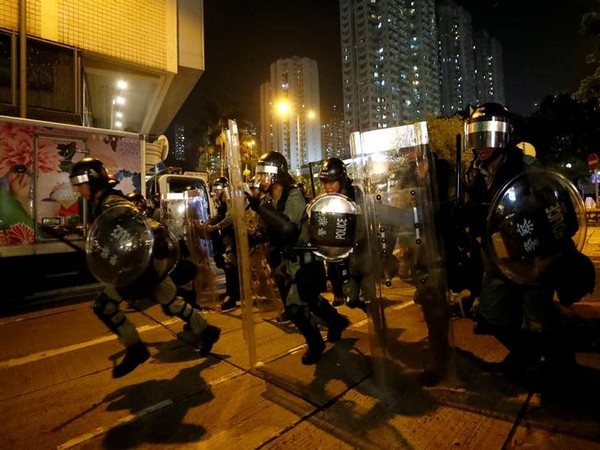Emergency Law Ordinance: Why Hong Kong anti-mask law is only tip of the iceberg
The Emergency Law Ordinance was last invoked during Hong Kong’s 1967 riots and gives the Chief Executive in Council power to “make any regulations” that he or she consider desirable in the public interest.

- Country:
- China
Hong Kong Chief Executive Carrie Lam has announced an anti-mask law by invoking the Emergency Law Ordinance. What this means is that protesters now won’t be able to hide their identities by using blackface masks, which have become a symbol of months-long protests in Hong Kong that choked the semi-autonomous region of China, even leading to the closure of its international airport more than once.
While announcing the regulation, Carrie Lam said that the move would help authorities in “enforcing the law,” adding that other countries also have similar rules. Violators can face up to 1 year in prison and/or a fine of HK$25,000 (INR 2,25,990).
Lam also didn’t rule out taking further steps under the Emergency Law Ordinance saying “other means to tackle the situation” would be considered if the protests worsen. The powers given to the Chief Executive under the Emergency Law Ordinance allow Lam to do much more than banning face masks and its ripple effects could extend far beyond Hong Kong.
Powers under Emergency Law Ordinance
The law was last invoked during Hong Kong’s 1967 riots and gives the Chief Executive in Council power to “make any regulations” that he or she considers desirable in the public interest, more specifically it includes censorship, and the control and suppression of publications, writings, maps, plans, photographs, communications and means of communication.
The Hong Kong government can effectively ban specific websites, offline publications, specific apps and can even shut down the internet or telephone connectivity. This provision, in particular, is very concerning to the international community considering Hong Kong is a major business hub. Many people also fear that this provision can cripple the freedom of the press. Further, it may affect:
- Arrest, detention, exclusion, and deportation,
- Control of the harbors, ports, and waters of Hong Kong, and the movements of vessels, and
- Transportation by land, air or water, and the control of the transport of persons and things
The government can restrict public transport means for protesters, including the Mass Transit Railway (MTR) and buses. Protesters have often claimed that the government is using public transport in their crackdown. The train services have often been suspended during the protests and horrific scenes of violence at MTR stations have made headlines several times in the last few months.
The provision also includes:
- Trading, exportation, importation, production, and manufacture,
- Appropriation, control, forfeiture and disposition of property, and of the use thereof,
- Amending any enactment, suspending the operation of any enactment and applying any enactment with or without modification, and
- Authorizing the entry and search of premises.
Under this provision, Hong Kong riot police can enter and search premises, including those of establishments selling protest gear.
Empowering such authorities or persons as may be specified in the regulations to make orders and rules and to make or issue notices, licenses, permits, certificates or other documents for the purposes of the regulations is also covered under the Emergency Law Ordinance.
The government can also give more power to Hong Kong riot police, which has already been tainted by claims of brutality. In once such incident, a protester was shot in the chest by a police officer only a few days ago which led to a further uproar in demonstrations.
The Ordinance doesn’t stop here and covers:
- Charging, in respect of the grant or issue of any license, permit, certificate or other documents for the purposes of the regulations, such fees as may be prescribed by the regulations,
- The taking of possession or control on behalf of the Chief Executive of any property or undertaking,
- Requiring persons to do work or render services,
- Payment of compensation and remuneration to persons affected by the regulations and the determination of such compensation, and
- The apprehension, trial, and punishment of persons offending against the regulations or against any law in force in Hong Kong.
Besides this, the Ordinance can also “contain such incidental and supplementary provisions as appear to the Chief Executive to be necessary or expedient for the purposes of the regulations.”
Penalties
The Emergency Law Ordinance also states that “regulations made hereunder may provide for the punishment of any offense” while also adding that the penalties can include “a maximum penalty of mandatory life imprisonment but excluding the penalty of death.”
In case the regulation made under this ordinance doesn’t state a penalty or punishment, the violator will be liable to a fine of HK$5,000 and to imprisonment for 2 years.
The violent protests in Hong Kong started from the residents opposing a bill that would have allowed extradition to the Chinese mainland. The bill stands withdrawn but the protests have expanded to a widespread call for increased democratic accountability and an independent inquiry into police violence. Given the powers under Emergency Law Ordinance, the government certainly can do a lot to try to quell protests, but the question is, at what cost?
(Disclaimer: The opinions expressed are the personal views of the author. The facts and opinions appearing in the article do not reflect the views of Devdiscourse and Devdiscourse does not claim any responsibility for the same.)
- FIRST PUBLISHED IN:
- Devdiscourse










